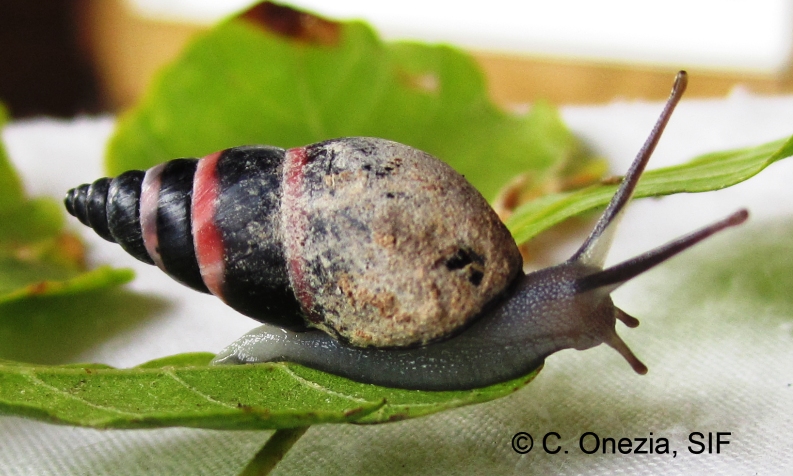Extinct snail re-discovered at Unesco Site Aldabra Atoll |01 September 2014
The Aldabra banded snail (Rhachistia aldabrae), declared extinct in 2007, has been re-discovered alive and well at the Unesco World Heritage Site of Aldabra Atoll, Seychelles.
Before the discovery, the last living individual of the species, which only occurs on Aldabra, was recorded in 1997. Subsequent searches yielded only shell remains. The snail’s apparent demise was linked to declining rainfall on Aldabra and was widely publicised internationally as one of the first casualties of climate change impacts.
The snails were spotted on Saturday August 23, 2014 by the keen eyes of junior skipper Shane Brice when he noticed a snail that he didn’t recognise in dense mixed scrub of a little-visited part of Aldabra.
“I was bush-bashing through the scrub when I spotted a mysterious snail that I’d never seen before on the island, I was very excited!” he said.
Senior ranger and assistant training officer Catherina Onezia’s suspicions were immediately raised as the snails were found on one of Aldabra’s endemic trees.
“When Shane showed me the snail I thought deep down, surely it can’t be the endemic snail! I only dared to believe it once I checked it out back at the office,” said Onezia.
On searching the area further, the team located several individuals, including juvenile snails. The discovery of the young snails is very encouraging as the last juveniles were recorded in 1976. The juvenile snails were considered to be particularly vulnerable to desiccation as a result of reduced rainfall.
The team of Seychelles Islands Foundation (SIF) staff were exploring infrequently visited parts of Malabar Island, the second largest island of Aldabra, when the snails were found. One of the aims of the field expedition was to document all of the invertebrates observed, but the team never dreamed that they would make such a find. The snails are unmistakeable, with beautiful elongated deep purple shells lined with bright pink bands. Identification of the snails has also been confirmed by mollusc experts Dr Vincent Florens (University of Mauritius) and Pat Matyot.
There is still very little known about the ecology of this rare snail but the rediscovery provides an incredible second chance to protect and study this historical species in the wild and ensure that it is not lost again. Climate change may not have caused the demise of this snail, but climate change impacts remain a likely threat to this species and many others globally.
The re-discovery of the Aldabra banded snail provides a beacon of hope.
SIF chief executive Dr Frauke Fleischer-Dogley said of the re-discovery: “Despite major global environmental threats like climate change, this discovery shows that investments into protecting unique island biodiversity are well-placed. This snail provides hope for other island species, of which we have already lost too many. I hope that those of the international community, who are meeting at the Third International Conference on Small Island Developing States, take note that their investment is needed to generate such success. Nature has a resilience that may surprise us.”
Aldabra Atoll, part of the Seychelles archipelago in the Western Indian Ocean, is one of the largest raised coral atolls on earth and is significantly less disturbed than most other coral atolls elsewhere in the world. Aldabra was designated a World Heritage Site by Unesco in 1982 and is managed and protected by the Seychelles Islands Foundation, a public trust established by legal decree in 1979.
Aldabra is a refuge for many endangered species including the world’s largest population of giant tortoises (Aldabrachelys gigantea) and one of the largest congregations of nesting green turtles (Chelonia mydas) in the Indian Ocean.
The Aldabra banded snail (Rhachistia aldabrae) is endemic to Aldabra where it has been recorded from the islands of Picard, Malabar, Polymnie, Esprit and Grande Terre (Gerlach, 2007). Malabar is the second largest island of the ring of islands that make up Aldabra Atoll, to the north of the lagoon.
Most invertebrate collections on Aldabra date back to the 1970s, with the exception of terrestrial molluscs. Land snail collections on Aldabra were first made in 1895, with occasional collections since then and extensive surveys in 1997, 2000 and 2005 (Gerlach, 2007).
Reference
Gerlach, J. (2007). "Short-term climate change and the extinction of the snail Rhachistia aldabrae (Gastropoda: Pulmonata)". Biology Letters 3 (5): 581–584

Contributed




